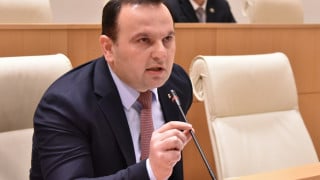Paata Manjgaladze: “Expenses for bureaucracy increase year by year and labour remuneration alone has increased by nearly GEL 200 million.”
Verdict: FactCheck concludes that Paata Manjgaladze’s statement is HALF TRUE.
Analysis
The Minister of Finance of Georgia, Lasha Khutsishvili, during his visit to the Parliament of Georgia as part of the Minister’s Hour, presented the Ministry’s work report followed by the Q&A session. MP from the Strategy Builder party, Paata Manjgaladze, underlined the growth of bureaucratic expenses and the growth of contract workers, stating: “Expenses for bureaucracy increase year by year and labour remuneration alone has increased by nearly GEL 200 million. The increase in these expenses is seen mostly for contract workers. In some agencies, the number of contract workers is above the necessary amount.”
Administrative or bureaucratic expenses are the sum of the funds allocated for labour remuneration and the purchase of goods and services. In order to analyse changes of bureaucratic expenses over time, it is more relevant to use the administrative expenses to the gross domestic product or budget appropriations ratio instead of using nominal figures. A comparison of the nominal figures of bureaucratic expenses is wrong, since the nominal figures of budget revenues and expenses in any case increase every year and, in addition, the inflation factor is also not excluded. Therefore, a comparison of nominal figures is not appropriate in order to discern a trend. Of note is that administrative expenses include expenses for defence, law and order (police and military) as well as for the salaries of teachers, doctors, etc., which means that administrative expenses do not only imply bureaucratic expenses.
Graph 1: Administrative Expenses Dynamics in 2012-2022 (GEL Million)

Source: Ministry of Finance of Georgia
As shown by the graph, the administrative expenses to the GDP ratio has been declining since 2016. In addition, the administrative expenses to the budget expenditures ratio is also decreasing except for 2021 when it rose slightly. Therefore, the first part of Paata Manjgaladze’s statement where he claims that the expenses for bureaucracy are constantly increasing is not true.
In regard to the growth of labour remuneration for this year, GEL 1,834,414,000 is envisioned for labour remuneration according to the 2022 budget plan which is GEL 194 million more as compared to the previous year (GEL 1,640,876,100). This growth is stipulated by a 10% growth of the basic salary of public servants effective from 1 January 2022. However, the growth of the salaries of public servants does not only imply a growth of the salaries for bureaucracy, since service members, policemen, teachers, etc., also had their salaries increased.
At the same time, the salaries of mayors, chairs and deputy chairs of municipality councils and staff members increased in most municipalities from 1 January 2022. Therefore, by indicating the growth of the salary fund, the author of the statement means a growth of bureaucratic expenses which is correct.
Whilst speaking about the number of public servants and official salaries, of particular interest has always been the number of contract workers and their labour remuneration.
According to the Law of Georgia on Remuneration in Public Institutions, a contract worker is an individual who is appointed to or accepted for work under on the basis of an employment contract for a certain period of time in order to accomplish non-permanent tasks (Article 8).
The employment of contract workers, as opposed to permanent workers (who are mostly appointed after undergoing a selection competition), involves relatively simpler procedures which increase the probability of nepotism and politically-motivated appointments as well as make them easier.
Based on state budget execution reports, we can make conclusions on the labour remuneration of contract workers in the public sector. However, the number of these employees is not indicated. the salaries of contract workers have been rising since 2011, except for 2013 when the salaries actually decreased. This can be explained by the fact that 2013 was the Georgian Dream’s first year in power and since they always scolded the United National Movement for the growth of the number of contract workers, they decided to cut the number and, therefore, the budget for the remuneration of contract workers. However, the growth trend was still in place in later years. The years 2012, 2014, 2015, 2020 and 2021 are distinguished in this respect when salary appropriations for contract workers increased by 60%, 65%, 28%, 22% and 22%, respectively.
As mentioned earlier, the budget execution reports do not contain figures about the number of contract workers employed in the entire public sector. However, we can take a look at the number of employees in government LEPLs and NNLEs.
Graph 2: Number of Employees in Government LEPLs and NNLEs

Source: Ministry of Finance, budget execution reports
According to the budget execution reports, the number of contract workers in government LLEPs and NNLEs has mostly been growing. The exceptions are 2017 and 2020 when the number of contract workers did drop.
Generally, of mention is that the practice of the last years shows that contract positions are largely occupied by individuals loyal to or affiliated with the ruling party. Their number increases mostly before the elections. There were elections in every year from 2012 to 2021 and, therefore, it is impossible to delineate any correlation between the number of contract workers and the growth of their salary appropriations with the elections in the reporting years. It is also important that the number of contract workers in budget organisations frequently exceeds the legally allowed threshold. The Information Freedom Development Institute’s study and audit reports include information about this.
Given the aforementioned circumstances, Paata Manjgaladze’s statement is HALF TRUE.








